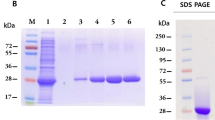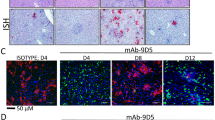Abstract
Severe fever with thrombocytopenia syndrome (SFTS) is a hemorrhagic fever caused by SFTS virus (SFTSV), which is primarily found in East Asian countries. Despite its high mortality rate and increasing incidence, no vaccines or therapeutics have yet been approved for use against SFTS. Antibody drugs have shown promise in treating lethal infectious diseases that currently have no established treatments. In the case of SFTS, however, only a limited amount of research has been done on SFTSV-neutralizing antibodies targeting the transmembrane proteins Gn and Gc, which play critical roles in viral infection. This study focuses on the production and characterization of antibodies targeting the SFTSV Gc protein. Monoclonal antibodies against Gc were generated through immunization of mice, and their antiviral activity was evaluated. Three out of four anti-Gc antibody clones from this study demonstrated dose-dependent SFTSV neutralization activity, two of which exhibited a synergistic effect on the neutralization activity of the anti-Gn antibody clone Mab4-5. Further studies are necessary to identify key sites on the SFTSV glycoprotein and to develop novel agents as well as antibodies with diverse mechanisms of action against SFTSV.


Similar content being viewed by others
Data availability
The monoclonal antibody sequences reported in this paper have been deposited in the NCBI database (B1D6 HC variable region, MW514299.1; B1D6 LC variable region, MW514300.1; C3A11 HC variable region, MW514301.1; C3A11 LC variable region, MW514302.1; C6C1 HC variable region, MW514305.1; C6C1 LC variable region, MW514306.1; C4H12 HC variable region, MW514303.1; and C4H12 LC variable region, MW514304.1).
References
Yu X-J, Liang M-F, Zhang S-Y et al (2011) Fever with thrombocytopenia associated with a novel bunyavirus in China. N Engl J Med 364:1523–1532. https://doi.org/10.1056/NEJMoa1010095
Yun SM, Lee WG, Ryou J et al (2014) Severe fever with thrombocytopenia syndrome virus in ticks collected from humans, South Korea, 2013. Emerg Infect Dis 20:1358–1361. https://doi.org/10.3201/eid2008.131857
Takahashi T, Maeda K, Suzuki T et al (2014) The first identification and retrospective study of severe fever with thrombocytopenia syndrome in Japan. J Infect Dis 209:816–827. https://doi.org/10.1093/infdis/jit603
Gai ZT, Zhang Y, Liang MF et al (2012) Clinical progress and risk factors for death in severe fever with thrombocytopenia syndrome patients. J Infect Dis 206:1095–1102. https://doi.org/10.1093/infdis/jis472
Sun JM, Zhang YJ, Gong ZY et al (2015) Seroprevalence of severe fever with thrombocytopenia syndrome virus in southeastern China and analysis of risk factors. Epidemiol Infect 143:851–856. https://doi.org/10.1017/S0950268814001319
Chen C, Li P, Li K-F et al (2018) Animals as amplification hosts in the spread of severe fever with thrombocytopenia syndrome virus: A systematic review and meta-analysis. https://doi.org/10.1016/j.ijid.2018.11.017
Park Esil, Shimojima M, Nagata N et al (2019) Severe Fever with Thrombocytopenia Syndrome Phlebovirus causes lethal viral hemorrhagic fever in cats. Sci Rep 9:1–18. https://doi.org/10.1038/s41598-019-48317-8
Yamanaka A, Kirino Y, Fujimoto S et al (2020) Direct Transmission of Severe Fever with Thrombocytopenia Syndrome Virus from Domestic Cat to Veterinary Personnel. Emerg Infect Dis 26:2994–2998. https://doi.org/10.3201/EID2612.191513
Saijo M (2018) Pathophysiology of severe fever with thrombocytopenia syndrome and development of specific antiviral therapy. J Infect Chemother 24:773–781
International Committee on Taxonomy of Viruses. In: Virus Taxonomy. https://talk.ictvonline.org/taxonomy/p/taxonomy-history?taxnode_id=20141803. Accessed 19 Jan 2021
Liu S, Chai C, Wang C et al (2014) Systematic review of severe fever with thrombocytopenia syndrome: Virology, epidemiology, and clinical characteristics. Rev Med Virol 24:90–102. https://doi.org/10.1002/rmv.1776
Plegge T, Hofmann-Winkler H, Spiegel M, Pöhlmann S (2016) Evidence that processing of the severe fever with thrombocytopenia syndrome virus Gn/Gc polyprotein is critical for viral infectivity and requires an internal Gc signal peptide. PLoS ONE 11. https://doi.org/10.1371/journal.pone.0166013
Dibo M, Battocchio EC, dos Santos Souza LM et al (2019) Antibody Therapy for the Control of Viral Diseases: An Update. Curr Pharm Biotechnol 20:1108–1121. https://doi.org/10.2174/1389201020666190809112704
Shimada S, Posadas-Herrera G, Aoki K et al (2015) Therapeutic effect of post-exposure treatment with antiserum on severe fever with thrombocytopenia syndrome (SFTS) in a mouse model of SFTS virus infection. Virology 482:19–27. https://doi.org/10.1016/j.virol.2015.03.010
Wang G, Chang H, Jia B et al (2019) Nucleocapsid protein-specific IgM antibody responses in the disease progression of severe fever with thrombocytopenia syndrome. Ticks Tick Borne Dis 10:639–646. https://doi.org/10.1016/j.ttbdis.2019.02.003
Yu L, Zhang L, Sun L et al (2012) Critical epitopes in the Nucleocapsid protein of SFTS virus recognized by a panel of SFTS patients derived human monoclonal antibodies. PLoS ONE 7. https://doi.org/10.1371/journal.pone.0038291
Jin J, Park C, Cho SH, Chung J (2018) The level of decoy epitope in PCV2 vaccine affects the neutralizing activity of sera in the immunized animals. Biochem Biophys Res Commun 496:846–851. https://doi.org/10.1016/j.bbrc.2018.01.141
Suzuki T, Sato Y, Sano K et al (2020) Severe fever with thrombocytopenia syndrome virus targets B cells in lethal human infections. J Clin Invest 130:799–812. https://doi.org/10.1172/JCI129171
Guo X, Zhang L, Zhang W et al (2013) Human antibody neutralizes severe fever with thrombocytopenia syndrome virus, an emerging hemorrhagic fever virus. Clin Vaccine Immunol 20:1426–1432. https://doi.org/10.1128/CVI.00222-13
Kim KH, Kim J, Ko M et al (2019) An anti-Gn glycoprotein antibody from a convalescent patient potently inhibits the infection of severe fever with thrombocytopenia syndrome virus. PLoS Pathog 15. https://doi.org/10.1371/journal.ppat.1007375
Taniguchi S, Fukuma A, Tani H et al (2017) A neutralization assay with a severe fever with thrombocytopenia syndrome virus strain that makes plaques in inoculated cells. J Virol Methods 244:4–10. https://doi.org/10.1016/j.jviromet.2017.01.005
Tani H, Shimojima M, Fukushi S et al (2016) Characterization of Glycoprotein-Mediated Entry of Severe Fever with Thrombocytopenia Syndrome Virus. J Virol 90:5292–5301. https://doi.org/10.1128/jvi.00110-16
Wu Y, Zhu Y, Gao F et al (2017) Structures of phlebovirus glycoprotein Gn and identification of a neutralizing antibody epitope. Proc Natl Acad Sci U S A 114:E7564–E7573. https://doi.org/10.1073/pnas.1705176114
Halldorsson S, Behrens AJ, Harlos K et al (2016) Structure of a phleboviral envelope glycoprotein reveals a consolidated model of membrane fusion. Proc Natl Acad Sci U S A 113:7154–7159. https://doi.org/10.1073/pnas.1603827113
Li Q, Liu Q, Huang W et al (2018) Current status on the development of pseudoviruses for enveloped viruses. Rev Med Virol 28
Dessau M, Modis Y (2013) Crystal structure of glycoprotein C from Rift Valley fever virus. Proc Natl Acad Sci U S A 110:1696–1701. https://doi.org/10.1073/pnas.1217780110
Du S, Peng R, Xu W et al (2023) Cryo-EM structure of severe fever with thrombocytopenia syndrome virus. Nat Commun 14:6333
Shimojima M, Sugimoto S, Umekita K et al (2022) Neutralizing mAbs against SFTS Virus Gn Protein Show Strong Therapeutic Effects in an SFTS Animal Model. https://doi.org/10.3390/v14081665. Viruses 14:
Kimura M, Egawa K, Ozawa T et al (2021) Characterization of pseudotyped vesicular stomatitis virus bearing the heartland virus envelope glycoprotein. Virology 556:124–132. https://doi.org/10.1016/j.virol.2020.10.006
Acknowledgments
The Chinese SFTSV strain HB-29 was a gift from Dr. Dexin Li and Dr. Mifang Liang of the National Institute for Viral Disease Control and Prevention, Chinese Center for Disease Control and Prevention.
Funding
This work was supported in part by the Emerging/Re-emerging Infectious Diseases Project of Japan from the Japan Agency for Medical Research and Development (AMED) under grant number JP23fk0108625 and the Interdisciplinary Cutting-Edge Research Program from AMED under grant number JP23wm0325034. The funders played no role in the study design, data collection and analysis, decision to publish, or preparation of the manuscript.
Author information
Authors and Affiliations
Contributions
Conceptualization, KS, TS; methodology, KS, MK, HT; investigation, KS, MK, AK, HT, HH, TS; data curation, KS, MK; formal analysis and visualization, KS; funding acquisition, HT, TS; project administration and supervision, HH, TS; writing – original draft, KS; writing – review and editing, KS, TS. All authors agreed to submit the manuscript, read and approved the final draft, and take full responsibility of its content including the accuracy of the data and statistical analysis.
Corresponding author
Ethics declarations
Conflict of interest
The authors have no relevant financial or non-financial interests to disclose.
Additional information
Communicated by Hideki Ebihara
Publisher’s Note
Springer Nature remains neutral with regard to jurisdictional claims in published maps and institutional affiliations.
Rights and permissions
Springer Nature or its licensor (e.g. a society or other partner) holds exclusive rights to this article under a publishing agreement with the author(s) or other rightsholder(s); author self-archiving of the accepted manuscript version of this article is solely governed by the terms of such publishing agreement and applicable law.
About this article
Cite this article
Sano, K., Kimura, M., Sataka, A. et al. Characterization of antibodies targeting severe fever with thrombocytopenia syndrome virus glycoprotein Gc. Arch Virol 169, 40 (2024). https://doi.org/10.1007/s00705-024-05968-x
Received:
Accepted:
Published:
DOI: https://doi.org/10.1007/s00705-024-05968-x




